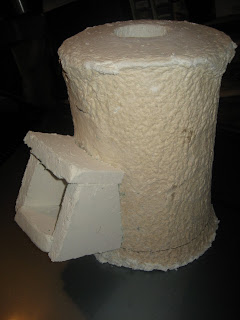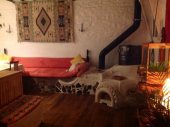Hi Kerry,
Thanks for the compliments.
The Tea Stump was a one-off; it didn't occur to me to put out plans for it, but I'm happy to share some
photos of the building process.


The refractory stuff we used was mostly a product called 'DuraBoard', a ceramic-fiber board with a starch binder. We also got a leftover piece of pipe insulation in the same material, 18" tall by 3" ID (it would fit around a 3" pipe).
You could also do a small stove lined with kiln brick, which can be ordered online and is soft enough to cut with household tools like a dull wood-saw (don't worry, if it's sharp when you start it will become properly dull very soon).
Or you could try making your own 'vernacular insulative ceramic' (google that phrase plus 'Uganda' for a description of a research team's efforts to build cleaner cookstoves using local materials).
I'd be tempted to take a page from Approvecho and use metal cans as the forms. Then fill in between with Ianto's favorite cheap refractory insulation, perlite mixed with clay slip. The outer can should remain intact and portable; if the inner can burns out, the clay helps keep the perlite from escaping.
You can do some punched-tin decoration on an outer can, or paint with woodstove or engine block paints to get something a little slicker. After using it a while, to test how hot the suface gets, you could even explore less heat-resistant materials for attractive and durable covers.
The attractive outer shell of the Tea Stump was made with Plaster of Paris and canvas strips - a page from my theater stage-set days. I made it a cedar stump because that was the easiest bark to immitate with the frayed edges of the canvas. Glad you liked it.
Yours,
Erica W








